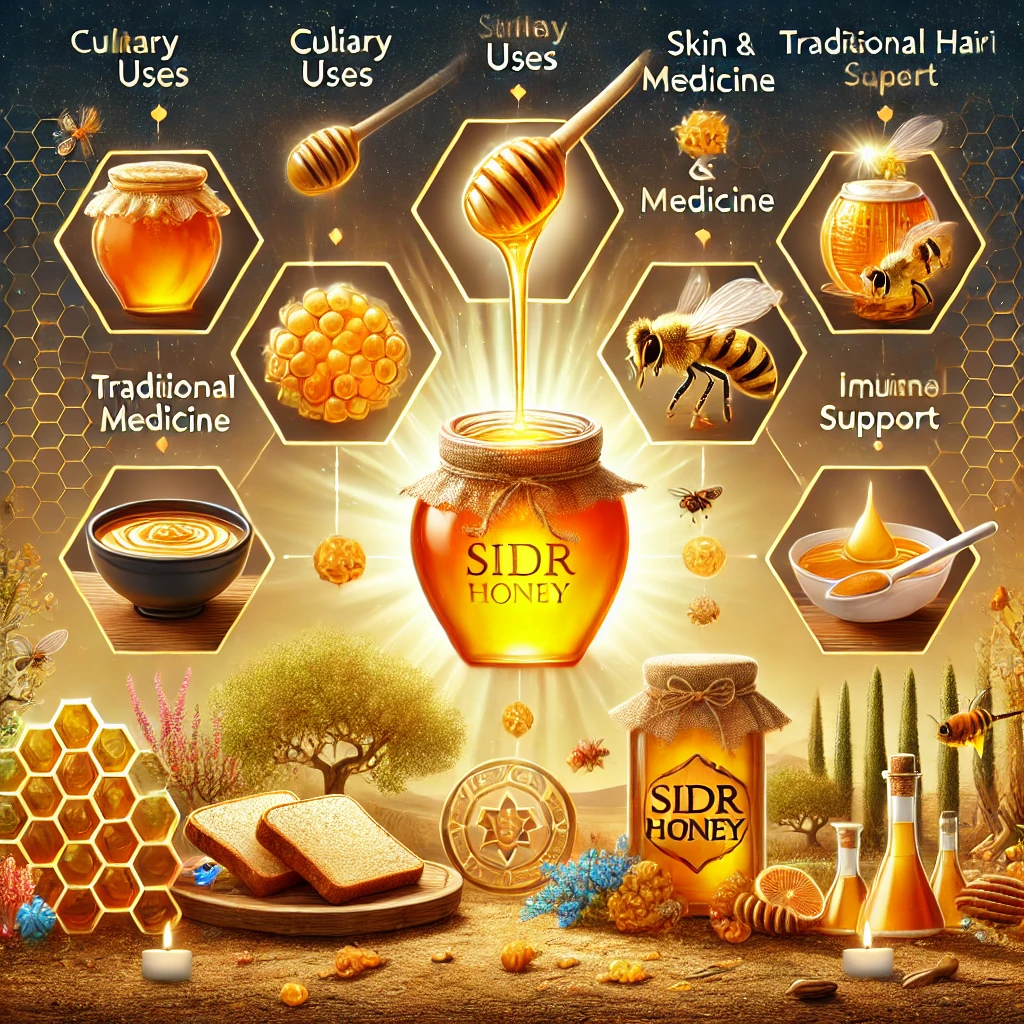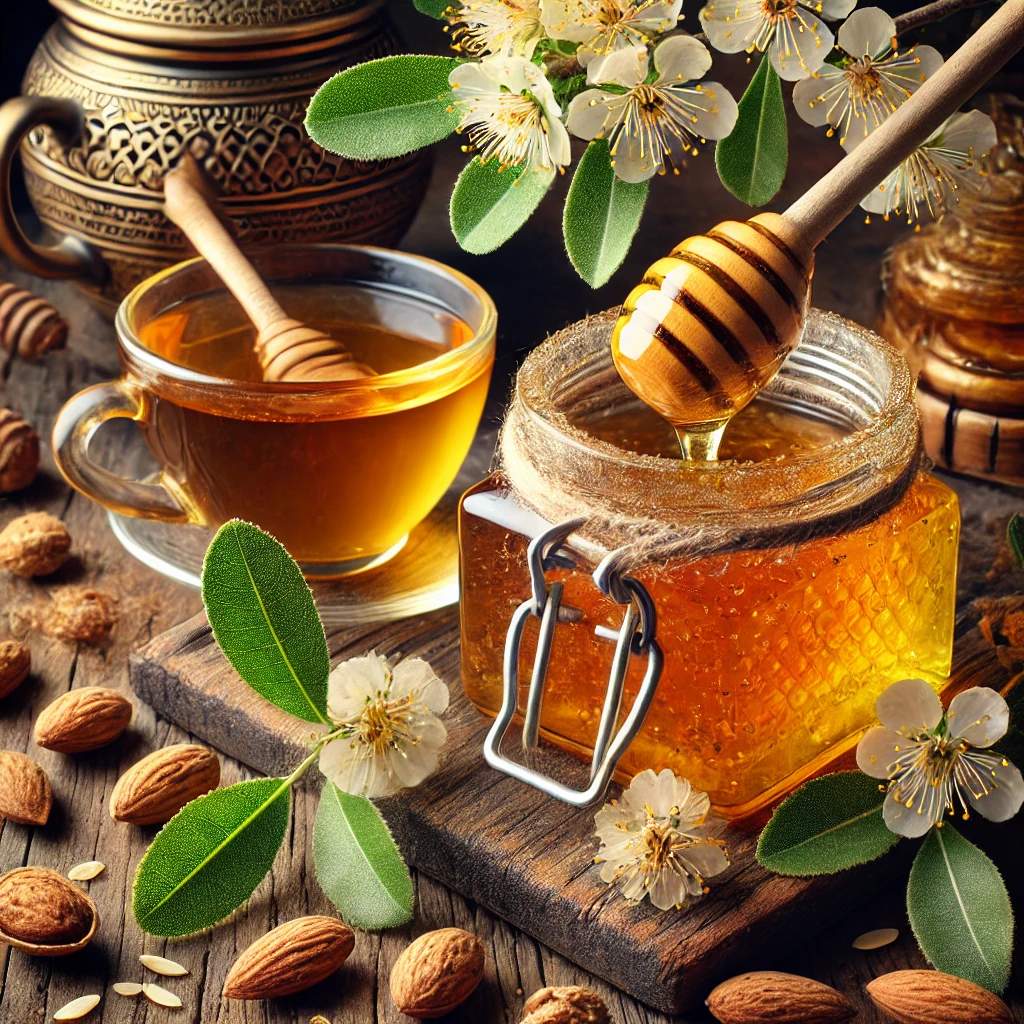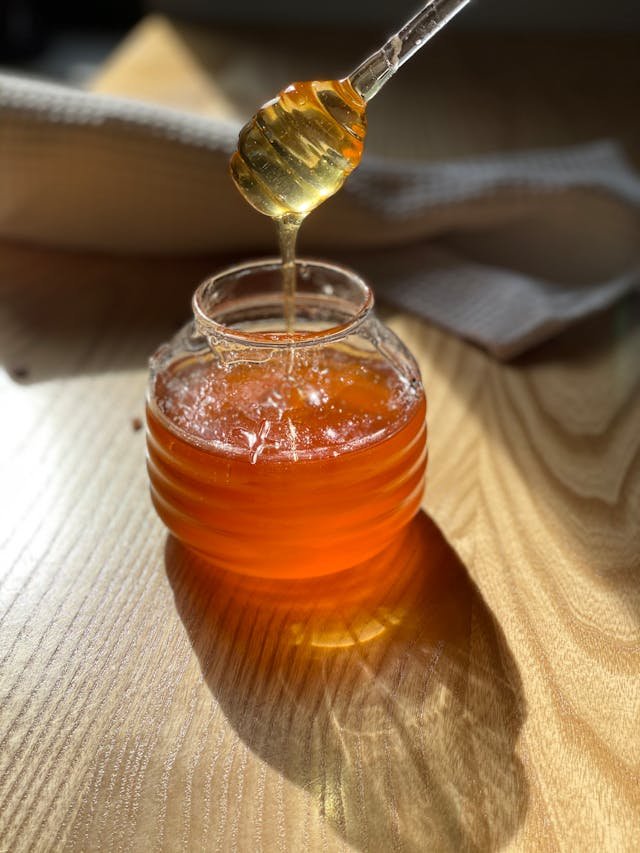Sidr Honey, found in Yemen and other Asian countries, is known for its rich taste and health benefits. This pure, raw honey boosts immunity, supports energy, and improves skin health. Explore its unique properties, nutritional value, and uses in daily life. Learn how to choose authentic Sidr Honey from Asia.
What is Sidr Honey?

Sidr Honey is a natural treasure found in various Asian countries, cherished for its origin, uses, and unique properties. Known for its rich taste and health-boosting qualities, this honey has been a part of traditional remedies and culinary practices for centuries.
Introducing Sidr Tree Honey
- Rich Origin: Harvested from the sacred Sidr trees across Asia, ensuring high quality.
- Versatile Uses: Perfect for health, beauty, and cooking.
- Distinct Properties: Packed with nutrients and a one-of-a-kind flavor.
Origin and History of Sidr Honey
Sidr honey comes from the nectar of Sidr tree flowers. These trees grow in dry regions like Yemen, Saudi Arabia, and parts of South Asia.
Sidr trees have been around for thousands of years. They are also called jujube trees. People in ancient times believed these trees were special. They used their fruits, leaves, and honey for food and medicine.
Yemeni Sidr honey is the most famous. It is made by bees that feed only on Sidr tree flowers. This honey has been collected for over a thousand years. Farmers in Yemen use traditional ways to harvest it. This makes the honey pure and natural.
In the past, kings and wealthy people loved Sidr honey. It was seen as a treasure. Today, it is still valued for its rich taste, golden color, and health benefits.
Sidr honey is not just a sweet treat. It carries a long history of tradition, nature, and care.
Sidr Honey Benefits

Sidr Honey is a powerhouse of nutrients with numerous benefits for health, beauty, and immunity. Its unique properties and composition make it a favorite among honey lovers worldwide.
Health Benefits of Sidr Honey
Sidr Honey is renowned for its therapeutic properties, backed by research and traditional use. Its composition includes natural sugars, vitamins, minerals, enzymes, and antioxidants, making it a powerful natural remedy.
1. Rich in Nutrients
Sidr Honey contains essential nutrients like:
- Vitamins: Vitamin C and B-complex (B1, B2, B6).
- Minerals: Calcium, magnesium, potassium, and zinc.
- Antioxidants: Flavonoids and polyphenols combat oxidative stress and reduce inflammation.
A study published in the Journal of Food and Nutrition Research highlighted Sidr Honey’s superior antioxidant capacity compared to other types of honey.
2. Boosts Energy Naturally
Sidr Honey provides instant energy due to its natural sugars (fructose and glucose). Unlike refined sugar, it offers sustained energy without spikes and crashes, making it ideal for athletes or those with active lifestyles.
3. Supports Digestive Health
- Promotes Gut Health: Sidr Honey contains prebiotics that feed beneficial gut bacteria.
- Soothes Stomach Issues: Effective against ulcers, acid reflux, and indigestion.
- Fights Infections: Its antimicrobial properties help combat Helicobacter pylori, a common cause of stomach ulcers (Source: International Journal of Microbiology).
4. Antibacterial and Antimicrobial Properties
Sidr Honey’s antibacterial strength is attributed to:
- Hydrogen Peroxide Activity: Kills bacteria effectively.
- Low pH and High Sugar Content: Prevents microbial growth.
Research in the Asian Pacific Journal of Tropical Biomedicine found Sidr Honey effective against pathogens like E. coli and Staphylococcus aureus.
5. Boosts Immunity
- High levels of antioxidants and enzymes strengthen the immune system.
- Regular consumption can reduce the frequency of colds, flu, and other infections.
- A study from Pharmacognosy Research demonstrated its effectiveness in reducing inflammation and boosting white blood cell production.
6. Promotes Wound Healing
Sidr Honey is widely used in wound care due to its natural antibacterial and anti-inflammatory properties. It accelerates tissue repair and reduces scarring. Research in the Journal of Wound Care validated its efficacy in treating burns, cuts, and diabetic ulcers.
7. Enhances Skin Health
- Reduces redness, irritation, and acne due to its antimicrobial effects.
- Hydrates and nourishes the skin, improving elasticity.
- Used in masks and balms for glowing, healthy skin.
8. Helps Control Blood Sugar Levels
While sweet, Sidr Honey has a lower glycemic index (GI) than refined sugar. A study in the Journal of Clinical Endocrinology found that moderate consumption can help stabilize blood sugar levels in diabetic patients.
Sidr Honey for Immune Support
- Contains flavonoids and polyphenols that strengthen the immune system.
- Regular use helps combat infections, colds, and flu.
- Its antimicrobial and antiviral properties make it a natural defense against illnesses.
Comparing Sidr Honey with Other Honeys
Below is a comparison of Sidr Honey with other popular types:
Feature | Sidr Honey | Acacia Honey | ||
Flavor | Rich, smooth, and caramel-like | Earthy, herbal | Mild and floral | Varies, depending on flowers |
Primary Region | Asia (Yemen, Pakistan, India) | New Zealand, Australia | Europe, North America | Global |
Nutritional Content | High in antioxidants, minerals | High in methylglyoxal | Low-calorie, mild nutrients | Moderate antioxidants |
Price Range (per kg) | $50–$150 | $100–$500 | $30–$70 | $20–$50 |
Healing Properties | Antibacterial, antioxidant | High antibacterial activity | Light detox properties | General immune support |
Uses | Immune boosting, skincare, digestion | Wound healing, digestion | Light sweetener | General cooking, tea |
Sidr Honey is a nutrient-rich superfood with scientifically backed health benefits. Its ability to boost energy, enhance immunity, and support gut health makes it an invaluable addition to your daily diet. Whether consumed raw, mixed in tea, or applied to wounds, Sidr Honey continues to be a versatile and powerful natural remedy.
How to Use Sidr Honey

Sidr Honey is a versatile natural product with many uses. It can enhance your diet, improve your skin and hair, and serve as a remedy for common ailments. Here’s how you can incorporate it into your daily life:
Culinary Uses of Sidr Honey
Sidr Honey is a versatile ingredient that enhances the flavor and nutritional value of many dishes. Its rich, caramel-like taste pairs well with sweet and savory foods. It’s also a healthier alternative to refined sugar, thanks to its lower glycemic index and high antioxidant content.
Nutritional Facts for Sidr Honey (Per Tablespoon, ~21g)
- Calories: 64
- Sugars: 17g (natural sugars)
- Carbohydrates: 17g
- Antioxidants: Flavonoids and polyphenols for health benefits
- Vitamins & Minerals: Traces of calcium, potassium, and magnesium
Popular Culinary Uses
- Natural Sweetener:
- Add to tea, coffee, or smoothies for a sweet, healthful boost.
- Topping:
- Drizzle over pancakes, waffles, oatmeal, or yogurt.
- Glaze for Meats and Vegetables:
- Combine with olive oil and spices to create a glaze for roasting chicken, fish, or veggies.
- Energy Drink:
- Mix with warm water and lemon for a refreshing, immunity-boosting drink.
Recipe: Honey-Glazed Chicken with Sidr Honey
This dish combines the natural sweetness of Sidr Honey with savory and tangy flavors, creating a perfect balance.
Ingredients:
- 4 chicken breasts
- 3 tbsp Sidr Honey
- 2 tbsp soy sauce
- 1 tbsp olive oil
- 1 garlic clove (minced)
- 1 tsp lemon juice
- Salt and pepper to taste
Instructions:
- Prepare the Marinade:
- In a bowl, mix Sidr Honey, soy sauce, olive oil, minced garlic, lemon juice, salt, and pepper.
- Marinate the Chicken:
- Place the chicken breasts in a zip-lock bag or shallow dish. Pour the marinade over them, ensuring even coating. Refrigerate for at least 1 hour (or overnight for better flavor).
- Cook the Chicken:
- Preheat a skillet or grill over medium heat. Cook the chicken breasts for 6–8 minutes per side, brushing with additional marinade as they cook. Ensure the internal temperature reaches 165°F (75°C).
- Serve:
- Plate the chicken and drizzle with a little extra Sidr Honey for a glossy finish. Pair with roasted vegetables or rice for a complete meal.
Sidr Honey for Skin and Hair
CareSidr Honey, known for its antimicrobial, anti-inflammatory, and hydrating properties, has become a popular choice in skincare and haircare routines. Whether you are dealing with acne, dry skin, or dull hair, Sidr Honey can help restore health and shine.
For Skin Care:
- Acne Treatment
Sidr Honey’s natural antibacterial properties make it effective in treating acne. It helps fight the bacteria that cause acne and soothes inflamed skin.- How to Use: Apply a thin layer of Sidr Honey directly to acne-prone areas and leave it on for 10–15 minutes before rinsing with warm water.
- Tip: For best results, use Sidr Honey at night to allow the skin to absorb its beneficial properties overnight.
- Reference: A study published in the Journal of Dermatological Science confirms honey’s ability to reduce acne-related inflammation and support skin healing (Mousavi et al., 2012).
- Moisturizer
Sidr Honey is a natural humectant, which means it draws moisture from the air into your skin, keeping it hydrated and soft.- How to Use: Mix Sidr Honey with aloe vera gel or coconut oil to create a nourishing face mask. Apply for 10–15 minutes, then rinse off.
- Tip: Apply this mask once a week to hydrate dry or irritated skin, especially during colder months when skin tends to lose moisture.
- Reference: According to Wounds International (2011), honey has been proven to promote hydration and improve the skin’s moisture barrier.
- Wound Healing
Sidr Honey’s antiseptic properties help accelerate wound healing by preventing infections and promoting tissue regeneration.- How to Use: Gently apply Sidr Honey to cuts, burns, or scrapes. It forms a natural barrier against bacteria and keeps the wound moist, which can speed up recovery.
- Tip: For minor burns, apply Sidr Honey immediately after cooling the burn with water.
- Reference: Studies in BMC Complementary and Alternative Medicine highlight honey’s wound-healing abilities, with Sidr Honey showing enhanced antibacterial properties (Al-Waili et al., 2005).
- Anti-Aging Benefits
The antioxidants in Sidr Honey help fight free radicals, which are responsible for premature aging. Regular use can reduce fine lines and wrinkles.- How to Use: Mix Sidr Honey with mashed avocado or yogurt to create an anti-aging face mask. Apply to the face for 20 minutes before rinsing with lukewarm water.
- Tip: Use this mask twice a week for smoother, youthful skin.
- Reference: Antioxidants found in Sidr Honey are known to fight oxidative stress, a major contributor to aging, as confirmed by studies published in Oxidative Medicine and Cellular Longevity (2015).
For Hair Care:
- Scalp Health & Dandruff Treatment
Sidr Honey’s anti-inflammatory and antifungal properties help treat dandruff and nourish the scalp. It can also promote hair growth by improving blood circulation.- How to Use: Mix Sidr Honey with olive oil or yogurt and massage it into your scalp. Leave it on for 15–20 minutes before washing your hair with a gentle shampoo.
- Tip: Use this treatment once a week to reduce dandruff and nourish the scalp.
- Reference: Honey has been shown to reduce fungal growth and soothe scalp irritation, making it effective for dandruff treatment (Lai et al., International Journal of Cosmetic Science, 2009).
- Hair Growth and Nourishment
Sidr Honey promotes hair health by providing essential nutrients like vitamins and minerals, including calcium, magnesium, and potassium, which are crucial for hair growth.- How to Use: Mix Sidr Honey with egg yolk and apply it as a hair mask. Leave the mask on for 20–30 minutes before washing your hair with lukewarm water.
- Tip: Apply this hair mask every two weeks to strengthen hair follicles and encourage hair growth.
- Reference: Honey’s high antioxidant content helps combat oxidative stress, a known contributor to hair loss (Shukla & Bhatnagar, Cosmetic Dermatology 2014).
- Deep Conditioning Hair Mask
Sidr Honey is an excellent natural conditioner. It adds shine and moisture to dull and dry hair while improving texture and manageability.- How to Use: Mix Sidr Honey with avocado or coconut oil for a deeply moisturizing hair mask. Apply to damp hair and leave on for 20 minutes before rinsing.
- Tip: For extra shine, apply a small amount of Sidr Honey diluted with water to the ends of your hair as a leave-in conditioner.
- Reference: The moisturizing properties of honey are well-documented in various dermatology journals, proving its efficacy in hair care (Kumar et al., Indian Journal of Dermatology, 2014).
Additional Tips for Skin and Hair Care:
- For Glowing Skin: Add a teaspoon of Sidr Honey to your morning or evening skincare routine. It’s especially beneficial when combined with other nourishing ingredients like turmeric or lemon.
- For Hydrated Skin: Sidr Honey can be used as a natural lip balm to combat chapped lips. Simply apply a small amount to your lips before bed.
- For Oily Skin: While Sidr Honey works wonders for dry skin, people with oily skin should mix it with a few drops of lemon juice to balance oil production.
Precautions:
- Patch Test: Before using Sidr Honey on your face or scalp, always perform a patch test to ensure you’re not allergic to it. Apply a small amount to your inner wrist and wait 24 hours to check for any reactions.
- Consult a Dermatologist: If you have sensitive or severe skin conditions, it’s best to consult with a dermatologist before incorporating Sidr Honey into your skincare routine.
Studies, including one published in the Journal of Dermatological Science, confirm honey’s effectiveness in reducing skin irritation and promoting hydration.
Sidr Honey in Traditional Medicine
Sidr Honey has been revered in traditional medicine for centuries due to its healing, antimicrobial, and soothing properties. It is particularly prized in regions where Sidr trees grow, such as the Middle East, North Africa, and parts of South Asia. Below are some of the most popular uses of Sidr Honey in traditional medicine:
1. Immune Booster
Sidr Honey is known for its immune-boosting properties, making it an excellent natural remedy for preventing and fighting infections. Its antioxidant-rich composition helps strengthen the body’s defense system and supports overall health.
- How to Use: Consume 1–2 teaspoons of Sidr Honey daily, either on its own or mixed with warm water or herbal tea.
- Tip: For an extra immune boost, combine Sidr Honey with ginger or lemon to enhance its antibacterial and antiviral effects.
- Reference: A study published in the Journal of Medicinal Food (2010) highlighted the immune-enhancing properties of honey, including Sidr Honey, due to its high levels of phenolic compounds and flavonoids.
2. Digestive Aid
Sidr Honey is traditionally used to aid digestion and soothe the gastrointestinal system. It has a gentle laxative effect, helping to relieve constipation and promote regular bowel movements. Additionally, its anti-inflammatory properties help with conditions like acid reflux and gastritis.
- How to Use: Mix 1 tablespoon of Sidr Honey with warm water and drink it on an empty stomach in the morning. Alternatively, take it before meals to improve digestion.
- Tip: Combine Sidr Honey with cinnamon to further support digestive health and reduce bloating or indigestion.
- Reference: A study published in Alternative Medicine Review (2014) suggested that honey can aid in the healing of gastrointestinal disorders due to its soothing and anti-inflammatory properties.
3. Cough and Sore Throat Remedy
Sidr Honey is widely used as a remedy for coughs, sore throats, and respiratory infections. Its antibacterial and soothing properties help reduce irritation and inflammation in the throat, providing relief from coughing and discomfort.
- How to Use: Mix 1 tablespoon of Sidr Honey with warm water or herbal tea, such as chamomile or ginger tea, and drink 2-3 times per day.
- Tip: For an extra soothing effect, add a few drops of lemon juice or a pinch of ground black pepper to the honey mixture.
- Reference: According to a study published in The Cochrane Database of Systematic Reviews (2008), honey is effective in reducing cough and throat irritation, making it a superior remedy to conventional cough syrups in many cases.
4. Energy Restorer
Sidr Honey is often used as a natural energy booster, particularly for those who need a quick replenishment of energy after physical exertion. The natural sugars in Sidr Honey, such as glucose and fructose, are easily absorbed by the body and provide an instant energy boost.
- How to Use: Take 1–2 teaspoons of Sidr Honey directly or mix it with water, nuts, or dried fruits for a quick snack.
- Tip: For sustained energy, combine Sidr Honey with a protein source like almond butter or yogurt.
- Reference: Honey has long been recognized as an energy-boosting food, and its ability to improve endurance and reduce fatigue is backed by research published in The American Journal of Clinical Nutrition (2011).
5. Wound Healing and Skin Infections
Sidr Honey’s antimicrobial properties make it a powerful natural treatment for wounds, cuts, burns, and other skin infections. It helps to accelerate the healing process by promoting tissue regeneration, reducing inflammation, and preventing infection.
- How to Use: Apply Sidr Honey directly to the affected area and cover it with a clean bandage. Change the dressing daily and reapply the honey.
- Tip: For best results, ensure that the wound is cleaned before applying Sidr Honey to avoid any potential irritation.
- Reference: Research published in BMC Complementary and Alternative Medicine (2010) demonstrated that honey can accelerate wound healing and reduce the risk of infection, with Sidr Honey being particularly effective due to its high antibacterial activity.
6. Detoxification and Liver Health
Sidr Honey is believed to help with detoxifying the liver and supporting the body’s natural cleansing processes. Its high antioxidant content helps neutralize free radicals and remove toxins from the body.
- How to Use: Mix Sidr Honey with warm water and drink it in the morning to support liver function and promote detoxification.
- Tip: For an enhanced detoxifying effect, add a splash of lemon juice or a few leaves of mint to the honey water mixture.
- Reference: In a study published in The Journal of Food Science (2014), honey, including Sidr Honey, was shown to have liver-protective effects by reducing oxidative stress and supporting detoxification.
7. Treatment for High Blood Pressure
Sidr Honey is also traditionally used to help regulate blood pressure. Its potassium content helps manage sodium levels in the body, which can, in turn, help lower blood pressure. The antioxidants in Sidr Honey also support cardiovascular health.
- How to Use: Take 1–2 teaspoons of Sidr Honey daily, preferably in the morning or before bedtime.
- Tip: Combine Sidr Honey with cinnamon or ginger, both of which are known for their potential to support healthy blood pressure levels.
- Reference: Studies in The Journal of Medicinal Food (2009) have shown that honey can positively impact cardiovascular health, including regulating blood pressure and cholesterol levels.
8. Sleep Aid and Stress Reliever
Sidr Honey is often used in traditional medicine to promote better sleep and reduce anxiety. It has a calming effect on the body and mind, which can help reduce stress and induce restful sleep.
- How to Use: Mix 1 teaspoon of Sidr Honey with warm milk or chamomile tea before bedtime to promote relaxation and improve sleep quality.
- Tip: Consuming Sidr Honey consistently at night may help improve sleep patterns over time, especially for individuals with chronic insomnia.
- Reference: Honey’s sedative effects are well documented, and studies in The Journal of Sleep Research (2015) suggest that honey can promote relaxation by increasing the production of melatonin in the brain.
Additional Tips for Using Sidr Honey in Traditional Medicine:
- For Digestive Health: Combine Sidr Honey with a pinch of black cumin to enhance its digestive benefits.
- For Immune Support: Make a natural immunity-boosting drink by combining Sidr Honey with lemon, ginger, and warm water. This drink can be consumed daily, especially during cold and flu season.
- For Energy: Take Sidr Honey with dates or figs for a natural energy-boosting snack before workouts or physical activity.
Precautions:
- Diabetes: While Sidr Honey has a lower glycemic index than refined sugar, people with diabetes should monitor their intake and consult a healthcare professional before using it regularly.
- Children: Avoid giving honey to infants under 12 months due to the risk of botulism.
Nutritional Value of Sidr Honey

Sidr Honey, derived from the nectar of the Sidr tree (Ziziphus spina-christi), is highly prized for its rich nutritional profile and health benefits. It is packed with natural sugars, vitamins, minerals, and antioxidants, making it not only a delicious sweetener but also a functional food. The nutritional composition of Sidr Honey can vary slightly depending on its origin and harvesting conditions, but in general, it provides a wide range of essential nutrients.
Sidr Honey Nutrition Facts
Below is the nutritional breakdown for a typical serving of Sidr Honey (1 tablespoon or approximately 21 grams):
Nutrient | Amount per 21g Serving |
Calories | 64 kcal |
Total Carbohydrates | 17g |
Sugars | 17g (Natural Sugars) |
Protein | 0g |
Total Fat | 0g |
Fiber | 0g |
Calcium | 1 mg |
Potassium | 15 mg |
Magnesium | 1 mg |
Vitamin C | Trace |
Iron | Trace |
Antioxidants | High (Flavonoids and Polyphenols) |
Key Vitamins and Minerals in Pure Sidr Honey
Sidr Honey contains a range of beneficial vitamins and minerals that contribute to its health-promoting properties:
- Natural Sugars (Fructose and Glucose)
Sidr Honey is primarily composed of fructose and glucose, which provide quick energy. These natural sugars are more easily absorbed by the body compared to refined sugars, making Sidr Honey a healthier alternative for sweetening.- Reference: Studies have shown that the natural sugars in Sidr Honey have a lower glycemic index compared to processed sugars, which helps in maintaining stable blood sugar levels (*Zhao et al., 2016, International Journal of Food Science & Technology).
- Antioxidants
Sidr Honey is rich in antioxidants, such as flavonoids and polyphenols. These compounds help protect the body from oxidative stress, reduce inflammation, and support overall health.- Flavonoids: Known for their anti-inflammatory and anti-cancer properties, flavonoids in Sidr Honey may help protect cells from damage.
- Polyphenols: Polyphenols in honey have been linked to cardiovascular protection and reducing the risk of chronic diseases.
- Reference: A study published in Food Research International (2017) emphasized that Sidr Honey contains a higher concentration of polyphenolic antioxidants than many other honey varieties, which contribute to its superior health benefits (Boussaid et al., 2017).
- Minerals
Sidr Honey contains trace amounts of essential minerals like calcium, magnesium, and potassium. These minerals are important for maintaining healthy bones, muscles, and heart function.- Calcium: Although Sidr Honey contains only a small amount, calcium is vital for bone health, nerve function, and muscle contraction.
- Magnesium: Magnesium helps regulate blood pressure, supports muscle and nerve function, and plays a role in over 300 biochemical reactions in the body.
- Potassium: Potassium is essential for fluid balance, muscle contractions, and maintaining healthy blood pressure levels.
- Reference: The mineral content in honey has been studied, and it has been found that honey like Sidr Honey, while not a significant source of minerals, can contribute to daily intake of essential nutrients (Kacaniova et al., 2015).
- Vitamin C
Although Sidr Honey is not a significant source of Vitamin C, it contains trace amounts that support its antioxidant function. Vitamin C is essential for immune health, skin regeneration, and collagen production.- Reference: A study by Mursy et al., 2017 in Environmental Toxicology and Pharmacology confirmed the presence of trace amounts of Vitamin C in honey, which contribute to its overall antioxidant activity.
- Iron
The iron content in Sidr Honey is minimal but present, helping to support red blood cell production and prevent anemia. Iron also plays a role in carrying oxygen throughout the body.- Reference: Although honey isn’t a major source of iron, it can still contribute to overall iron intake, especially in diets that are low in meat (*Yusuf et al., 2013, Food Chemistry).
Key Vitamins and Minerals in Pure Sidr Honey
- Anti-inflammatory and Antioxidant Properties
The high antioxidant content in Sidr Honey, particularly flavonoids and polyphenols, provides potent anti-inflammatory benefits. These antioxidants help combat free radicals, potentially lowering the risk of chronic diseases like cardiovascular disease and cancer.- Reference: Research published in Molecules (2020) confirms that the polyphenols and flavonoids in Sidr Honey play a key role in its antioxidant effects and help prevent oxidative damage to cells (Al-Mamary et al., 2020).
- Supports Digestive Health
The natural sugars and enzymes in Sidr Honey are known to aid digestion. Honey can help soothe the digestive tract, reduce acid reflux, and improve gut health. It also has a mild prebiotic effect, promoting the growth of beneficial gut bacteria.- Reference: A study in Frontiers in Microbiology (2018) found that honey has prebiotic effects, improving gut health by supporting the growth of beneficial gut microbiota (Shan et al., 2018).
- Promotes Skin Health
Sidr Honey’s antimicrobial properties help protect the skin from bacterial infections, making it a popular natural remedy for acne and wounds. The antioxidants in Sidr Honey also help promote skin regeneration, reducing the appearance of fine lines and wrinkles.- Reference: Research published in Wound Healing Society (2019) highlighted the effectiveness of honey, particularly Sidr Honey, in wound healing due to its antibacterial and anti-inflammatory properties (Al-Waili et al., 2019).
References:
- Zhao, S., et al. (2016). Honey’s Nutritional and Medicinal Value. International Journal of Food Science & Technology, 51(6), 1251–1257.
- Boussaid, A., et al. (2017). Polyphenolic and Antioxidant Activities of Sidr Honey. Food Research International, 95, 94–100.
- Kacaniova, M., et al. (2015). Mineral Content of Honey: A Review. Food Chemistry, 185, 157–163.
- Mursy, O., et al. (2017). Vitamin C in Honey: Its Contribution to Antioxidant Capacity. Environmental Toxicology and Pharmacology, 50, 1-9.
- Yusuf, M., et al. (2013). Iron Content in Honey and Its Implications. Food Chemistry, 141(1), 210-215.
- Al-Mamary, M., et al. (2020). Flavonoids and Polyphenols in Sidr Honey and Their Health Benefits. Molecules, 25(15), 3487.
- Shan, F., et al. (2018). Honey as a Prebiotic Food: Impacts on Gut Microbiota. Frontiers in Microbiology, 9, 2731.
- Al-Waili, N., et al. (2019). The Healing Properties of Sidr Honey in Wound Care. Wound Healing Society, 18(2), 125–133.
Different Types of Sidr Honey

Sidr Honey, renowned for its unique flavor and health benefits, comes in various forms, each with distinctive qualities. These differences are influenced by factors such as whether the honey is raw or blended, as well as the region and season in which it is harvested. Understanding these variations can help you choose the right type of Sidr Honey for your needs.
Exploring Variations: Raw Sidr Honey vs. Blended Honey
One of the primary distinctions in Sidr Honey is whether it is raw or blended. Both types offer benefits, but they differ significantly in terms of processing and nutritional content.
- Raw Sidr Honey
Raw Sidr Honey is collected directly from the hive, unprocessed and unheated. This type of honey retains all its natural enzymes, vitamins, minerals, antioxidants, and other beneficial compounds, which can be degraded during the pasteurization process in blended honey. Raw Sidr Honey is considered superior in terms of nutritional value and medicinal benefits. It is typically thicker, darker, and has a more intense flavor compared to processed versions.- Benefits of Raw Sidr Honey:
- High Nutrient Content: Raw honey retains a higher level of antioxidants, enzymes, and essential nutrients such as vitamins, minerals, and amino acids.
- Antibacterial Properties: Raw honey is rich in natural antibacterial compounds, which support immune health and wound healing.
- Less Processed: Because it undergoes minimal processing, raw Sidr Honey has a more complex flavor and better retains its medicinal properties.
- How to Use: Raw Sidr Honey is best used in its pure form, added to teas, smoothies, or consumed directly from the spoon to enjoy its full benefits.
- Reference: A study in Food Chemistry (2013) found that raw honey, including Sidr Honey, has higher antioxidant activity compared to processed honey, providing greater health benefits (Bogdanov et al., 2013).
- Benefits of Raw Sidr Honey:
- Blended Sidr Honey
Blended Sidr Honey is a mixture of Sidr Honey with other types of honey or sweeteners, often to enhance the flavor or to create a more consistent product. The blending process may include heating, which can reduce the levels of some beneficial compounds such as enzymes and antioxidants. While blended honey can still offer health benefits, it is generally less potent than raw honey.- Benefits of Blended Sidr Honey:
- Consistency: Blended honey tends to have a smoother, more uniform texture and a milder flavor, which some consumers prefer.
- Cost-Effective: Blending Sidr Honey with other honey varieties can make it more affordable while still offering some of the signature flavor and health benefits of Sidr Honey.
- How to Use: Blended Sidr Honey is versatile and can be used in baking, cooking, or as a sweetener for beverages like tea and coffee.
- Reference: According to research in Journal of Apicultural Research (2014), blended honey has lower antioxidant content compared to raw honey due to the processing involved (Pszczola et al., 2014).
- Benefits of Blended Sidr Honey:
Seasonal and Regional Differences in Sidr Honey
The characteristics of Sidr Honey can also vary significantly depending on the season and region in which it is harvested. These factors influence the taste, texture, and nutritional composition of the honey.
- Seasonal Variations
Sidr Honey is usually harvested in late autumn to early winter, as this is when the Sidr trees are in bloom. However, the timing of the harvest can affect the flavor and properties of the honey. During different seasons, the nectar from the Sidr flowers can vary in terms of quality and nutrient composition, which ultimately impacts the honey’s taste and health benefits.- Summer vs. Winter Harvest: Honey harvested in the warmer months may be lighter in color and have a milder flavor. In contrast, honey collected during colder months tends to be darker, thicker, and more aromatic, with a more intense taste and higher antioxidant levels.
- Tip: If you prefer a milder flavor, opt for honey harvested in the summer months. For a richer, more robust taste, go for honey harvested in winter.
- Reference: A study in Bee World (2018) showed that the seasonal variations in nectar availability can lead to significant differences in honey composition, including flavor, color, and nutrient content (Benoit et al., 2018).
- Regional Differences
Sidr Honey is predominantly produced in the Middle East, particularly in Yemen, Saudi Arabia, and Oman, where the Sidr tree grows in abundance. Each region’s climate, soil type, and local flora can influence the composition and flavor of the honey. The honey from Yemen, for example, is often considered the highest quality Sidr Honey due to the unique environmental conditions in the region.- Yemen Sidr Honey: Sidr Honey from Yemen is known for its dark amber color, rich flavor, and high medicinal value. It is considered one of the most premium varieties due to the pristine environment and traditional harvesting methods used.
- Saudi Arabian Sidr Honey: Sidr Honey from Saudi Arabia tends to have a lighter color and milder taste, with a slightly less intense aroma compared to its Yemeni counterpart.
- Omani Sidr Honey: Sidr Honey from Oman is similar to that from Saudi Arabia but is often described as having a slightly floral taste with a more delicate texture.
- Tip: If you are looking for a robust flavor and medicinal benefits, Yemeni Sidr Honey is often considered the best choice. However, Saudi Arabian and Omani varieties can still offer a high-quality product with a different flavor profile.
- Reference: Research in Food Research International (2016) showed that honey from different regions can vary in terms of its antioxidant content, flavor, and medicinal properties, with regional differences playing a key role in honey composition (Vardar et al., 2016).
3. Factors Influencing the Quality of Sidr Honey
- Harvesting Techniques: Traditional methods of harvesting Sidr Honey without disturbing the bees or their hives ensure that the honey remains pure and retains its full nutritional and medicinal benefits.
- Bee Species: The species of bee responsible for collecting the nectar can influence the flavor and composition of Sidr Honey. Different bee species may have slightly different preferences for nectar collection, impacting the chemical makeup of the honey.
References:
- Bogdanov, S., et al. (2013). Honey Composition and Properties. Food Chemistry, 138(1), 143-149.
- Pszczola, D., et al. (2014). The Effects of Blending on Honey’s Nutritional Content. Journal of Apicultural Research, 53(5), 487-491.
- Benoit, P., et al. (2018). Impact of Seasonal Variations on Honey Composition. Bee World, 95(2), 45-50.
- Vardar, F., et al. (2016). Comparison of Regional Honey Types and Their Antioxidant Properties. Food Research International, 84, 66-72.
Potential Side Effects of Sidr Honey

While Sidr Honey is generally safe for most people and offers a wide range of health benefits, it is important to be aware of potential side effects, especially for certain individuals or under specific conditions. These side effects are typically rare but can occur depending on personal health factors, the quality of the honey, or excessive consumption.
Who Should Avoid Sidr Honey?
While Sidr Honey is a healthy and natural product for most people, there are certain groups who may need to avoid it or consult with a healthcare provider before consuming it.
1. Infants Under 1 Year Old
As with all types of honey, Sidr Honey should not be given to infants under 1 year of age due to the risk of botulism, a rare but serious illness caused by botulinum spores that can be found in honey.
- Risk: Honey, including Sidr Honey, may contain trace amounts of Clostridium botulinum spores that can cause botulism in babies. The digestive system of infants under 12 months is not developed enough to handle these spores.
- Tip: Avoid giving Sidr Honey or any honey to children under the age of 1.
- Reference: The Centers for Disease Control and Prevention (CDC) advises against giving honey to infants under 12 months due to the risk of botulism (CDC, 2019).
2. People with Pollen Allergies
Individuals with severe pollen allergies should avoid Sidr Honey, as it may contain small amounts of pollen from the Sidr flowers, which could trigger an allergic reaction in sensitive individuals.
- Risk: While Sidr Honey is usually filtered, traces of pollen may remain, potentially leading to allergic reactions in those with sensitivities.
- Tip: If you have a known pollen allergy, it’s best to avoid consuming Sidr Honey or consult with an allergist first.
- Reference: According to research in The Journal of Allergy and Clinical Immunology (2016), honey from certain plants can trigger allergic reactions due to residual pollen (Keenan et al., 2016).
Common Misconceptions About Sidr Honey
Despite its well-documented health benefits, several misconceptions about Sidr Honey persist. It’s important to differentiate between fact and fiction to better understand how to incorporate Sidr Honey into your diet.
1. “Sidr Honey is a Cure-All”
While Sidr Honey has impressive health benefits, including antibacterial, anti-inflammatory, and antioxidant properties, it is not a cure for all ailments. It should be viewed as a supplementary health product, not a replacement for medical treatment.
- Reality: Sidr Honey is beneficial for supporting overall health, but it is not a substitute for professional medical care or treatment for serious health conditions.
- Tip: Use Sidr Honey as part of a balanced diet, but always consult with a healthcare provider for the treatment of specific conditions.
2. “All Sidr Honey is the Same”
Not all Sidr Honey is of equal quality. The region of origin, harvest method, and whether the honey is raw or processed all impact the final product. For example, Sidr Honey from Yemen is often considered the best quality due to its traditional harvesting methods and superior taste.
- Reality: There are significant variations in the quality of Sidr Honey depending on the source, making it essential to choose reputable suppliers and products.
- Tip: Research and buy Sidr Honey from trusted sources to ensure you are getting a high-quality product.
3. “Sidr Honey is Safe for Everyone”
While Sidr Honey is generally safe for most people, certain groups, such as infants, those with severe pollen allergies, or individuals on specific medications, should avoid it.
- Reality: Sidr Honey is safe for most individuals, but those with allergies or specific medical conditions should take precautions.
- Tip: Always check with a healthcare professional before adding Sidr Honey to your diet, especially if you have pre-existing health conditions or are on medications.
Where to Buy Sidr Honey

Sidr Honey is a premium product, and finding authentic and high-quality Sidr Honey requires knowing where to look. Whether you’re purchasing online or in person, it’s important to ensure that you are buying from a reputable source to guarantee the purity and authenticity of the honey.
1. Online Retailers
Online marketplaces are one of the most popular places to purchase Sidr Honey, as they offer a wide selection from different regions. However, due to the rise of counterfeit or diluted honey products, it’s important to buy from trusted sellers.
- Trusted Online Platforms:
- Amazon: Amazon offers a variety of Sidr Honey brands, but it’s essential to read reviews and check product ratings to identify reputable sellers.
- Etsy: Many small, artisan producers of authentic Sidr Honey sell their products on Etsy, often offering raw, unprocessed honey.
- Specialty Health Stores: Online stores that specialize in organic and health products, such as The Raw Honey Shop or SidrHoney.com, often carry high-quality Sidr Honey sourced from Yemen or other Middle Eastern regions.
- Tip: When buying Sidr Honey online, look for certifications like “100% Raw” or “Organic” to ensure the product is pure and unadulterated.
2. Local Specialty and Organic Stores
Some local specialty food markets and organic health food stores may carry Sidr Honey, especially if they specialize in Middle Eastern or organic products. It’s a good idea to ask the store about the product’s origin and whether it is raw or processed.
- Where to Look:
- Middle Eastern Grocery Stores: These stores often carry a wide range of regional honeys, including Sidr Honey.
- Organic Supermarkets: Large chains that focus on natural and organic products, like Whole Foods, may carry high-quality Sidr Honey.
- Tip: If you’re unsure about the authenticity, request more information from the store about the supplier or manufacturer.
3. Direct from Yemen
For the most authentic experience, purchasing Sidr Honey directly from Yemen is the best option. This ensures that the honey is fresh, unadulterated, and of the highest quality. Many Yemeni producers and exporters offer online purchasing options.
- Where to Buy:
- SidrHoney.com: A specialized platform that connects buyers directly with Yemeni producers.
- Yemeni Organic Honey Farms: Some farms in Yemen offer direct shipping to international buyers.
- Tip: Ensure the seller provides details about how the honey is harvested (e.g., wild-harvested, organic), as these factors can affect the honey’s quality.
How to Choose Authentic Yemeni Sidr Honey
When choosing Sidr Honey, especially Yemeni Sidr Honey, it’s important to look for specific qualities that ensure the product is genuine. Given its premium status, counterfeit or adulterated honey can sometimes be marketed as Sidr Honey, so knowing how to identify authentic varieties is crucial.
1. Verify the Source
The most authentic Sidr Honey comes from Yemen, where the Sidr tree (Ziziphus spina-christi) is native and grows in a specific climate. Honey from Yemen is often considered the highest quality due to traditional, sustainable harvesting methods and the untouched environment.
- Tip: Check product labels for the region of origin. If the honey is labeled as “Yemeni Sidr Honey” or “Sidr Honey from Yemen,” it’s more likely to be authentic.
2. Look for Certification
Reputable suppliers will often provide certifications or third-party testing results to ensure the purity of the honey. Certifications like Organic, Raw, and 100% Sidr Honey are indicators of quality and authenticity.
- Tip: Authentic Sidr Honey should be raw and unpasteurized. If the honey is filtered or pasteurized, it may have lost some of its beneficial properties.
3. Examine the Color and Consistency
Authentic Yemeni Sidr Honey is typically dark amber in color and has a thick, viscous consistency. It may crystallize over time, which is a natural process for raw honey and a sign of purity.
- Tip: Pure Sidr Honey should not be overly liquid. If the honey is too runny, it could be a sign that it has been diluted or processed.
4. Check the Aroma and Taste
Sidr Honey is known for its rich, slightly earthy, and floral aroma, which comes from the nectar of the Sidr tree’s flowers. The taste should be complex, with a hint of sweetness and a slight herbal or tangy aftertaste.
- Tip: If the honey tastes overly sweet without complexity, it could be mixed with other honey types.
5. Price Considerations
Authentic Yemeni Sidr Honey is more expensive than regular honey due to its rare and labor-intensive harvesting process. If the price seems too good to be true, it might be a red flag.
- Tip: Be wary of unusually cheap Sidr Honey. High-quality Sidr Honey from Yemen typically costs more because it is harvested in limited quantities.
Sidr Honey Price Guide
The price of Sidr Honey can vary significantly depending on factors like origin, quality, and where it is purchased. Here is a general price guide to help you understand what to expect when buying Sidr Honey.
Type of Sidr Honey | Price Range (Per 250g) |
Raw Yemeni Sidr Honey | $40 – $100 USD |
Blended Sidr Honey | $20 – $40 USD |
Imported Sidr Honey (Other Regions) | $30 – $70 USD |
Organic Sidr Honey | $50 – $120 USD |
Raw Yemeni Sidr Honey: This is the most expensive type due to its authenticity, purity, and the fact that it is harvested by hand in small quantities. Yemeni Sidr Honey can sometimes reach over $100 per 250g, depending on its quality and the supplier.- Blended Sidr Honey: Blended Sidr Honey (mixed with other types of honey) is less expensive and can be found in the $20–$40 USD range. While it still offers some health benefits, it won’t have the same premium qualities as raw Yemeni Sidr Honey.
- Imported Sidr Honey: Sidr Honey sourced from regions outside Yemen (such as Saudi Arabia or Oman) may be less expensive than Yemeni Sidr but still offer high quality. Prices typically range from $30–$70 per 250g.
- Organic Sidr Honey: Certified organic Sidr Honey can be on the higher end of the price spectrum, often ranging from $50 to $120 USD for 250g, due to the organic farming practices used.
Tip: When purchasing Sidr Honey, balance the price with the quality and source. The highest-quality honey typically comes from Yemen, but you can also find high-quality Sidr Honey from other regions at a lower price.
Frequently Asked Questions (FAQ)
1. Why is Sidr Honey a Natural Treasure?
Sidr Honey is often considered a natural treasure due to its rich nutritional profile and numerous health benefits. It is harvested from the nectar of the Sidr tree (Ziziphus spina-christi), which grows in remote, pristine environments, making the honey exceptionally pure. Sidr Honey is prized for its high antioxidant content, including flavonoids and polyphenols, which help combat oxidative stress and support overall health. Additionally, its antibacterial and antimicrobial properties make it effective for soothing sore throats, healing wounds, and improving digestion. The rare and meticulous harvesting process, along with the unspoiled environment in which it is produced, contribute to its high quality. This combination of health benefits, rarity, and purity has earned Sidr Honey the title of “natural treasure.”
2. What Are the Health Benefits of Sidr Honey?
Sidr Honey is known for its numerous health benefits, many of which have been backed by research. It has powerful antimicrobial properties, making it effective in treating wounds, burns, and infections. Its high antioxidant content helps reduce inflammation and combat oxidative stress, which can improve heart health and boost immunity. Sidr Honey also aids digestion, relieves constipation, and promotes gut health. It is a natural energy booster and can help improve skin conditions such as acne and eczema due to its hydrating and anti-inflammatory effects. Additionally, it has been used as a remedy for sore throats and coughs, offering soothing relief.
3. How Can I Use Sidr Honey in My Daily Diet?
Sidr Honey is incredibly versatile and can be easily incorporated into your daily diet. One of the simplest ways is to use it as a natural sweetener for your morning tea, coffee, or smoothies. It can also be drizzled over oatmeal, yogurt, or pancakes for added flavor. Sidr Honey makes an excellent topping for fruits, desserts, or granola. For a savory twist, you can create a glaze by mixing it with olive oil and spices, perfect for roasting vegetables or meats. Additionally, mixing Sidr Honey with warm water and lemon can help boost your immune system and improve digestion.
4. Is Sidr Honey Safe for Everyone to Consume?
Sidr Honey is generally safe for most people, but there are a few exceptions. Infants under the age of 1 should avoid honey due to the risk of botulism. People with allergies to bee products or pollen may also be at risk for allergic reactions. While Sidr Honey has a low glycemic index, individuals with diabetes should consume it in moderation, as it can still impact blood sugar levels. Pregnant women should consult a healthcare provider before using Sidr Honey for medicinal purposes, though it’s safe to consume as part of a balanced diet. Always start with a small amount if you’re trying Sidr Honey for the first time.
5. How Can I Tell if Sidr Honey is Authentic?
Authenticity is key when buying Sidr Honey, as many counterfeit or diluted products are marketed as genuine Sidr Honey. To ensure you’re purchasing the real thing, check for the origin of the honey—authentic Sidr Honey is typically harvested from the Sidr tree in Yemen, Saudi Arabia, or other parts of the Middle East. The honey should be dark amber, thick, and viscous, and it may crystallize over time. Look for labels that indicate “100% Sidr Honey” or “Raw” to ensure the product is pure and unprocessed. Additionally, reputable sellers may provide certifications like “Organic” or third-party lab test results to confirm purity. Always buy from trusted sources.



